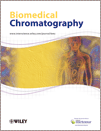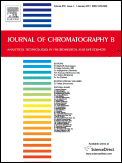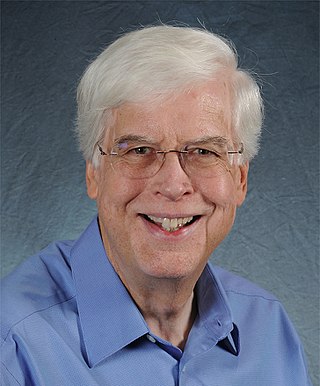
Analytical chemistry studies and uses instruments and methods to separate, identify, and quantify matter. In practice, separation, identification or quantification may constitute the entire analysis or be combined with another method. Separation isolates analytes. Qualitative analysis identifies analytes, while quantitative analysis determines the numerical amount or concentration.
In chemical analysis, chromatography is a laboratory technique for the separation of a mixture into its components. The mixture is dissolved in a fluid solvent called the mobile phase, which carries it through a system on which a material called the stationary phase is fixed. Because the different constituents of the mixture tend to have different affinities for the stationary phase and are retained for different lengths of time depending on their interactions with its surface sites, the constituents travel at different apparent velocities in the mobile fluid, causing them to separate. The separation is based on the differential partitioning between the mobile and the stationary phases. Subtle differences in a compound's partition coefficient result in differential retention on the stationary phase and thus affect the separation.

Analytical Chemistry is a biweekly peer-reviewed scientific journal published since 1929 by the American Chemical Society. Articles address general principles of chemical measurement science and novel analytical methodologies. Topics commonly include chemical reactions and selectivity, chemometrics and data processing, electrochemistry, elemental and molecular characterization, imaging, instrumentation, mass spectrometry, microscale and nanoscale systems, -omics, sensing, separations, spectroscopy, and surface analysis. It is abstracted and indexed in Chemical Abstracts Service, CAB International, EBSCOhost, ProQuest, PubMed, Scopus, and the Science Citation Index Expanded. According to the Journal Citation Reports, it has a 2020 impact factor of 6.986. The editor-in-chief is Jonathan V. Sweedler.

Biomedical Chromatography is a monthly peer-reviewed scientific journal, published since 1986 by John Wiley & Sons. It covers research on the applications of chromatography and allied techniques in the biological and medical sciences. The editor-in-chief is Michael Bartlett.
The Journal of Labelled Compounds and Radiopharmaceuticals is a peer-reviewed scientific journal that was established in 1965. It is published in fourteen issues per year by John Wiley & Sons on behalf of the International Isotope Society and covers all aspects of research and development leading to and resulting in labelled compound preparation. The current editor-in-chiefs are R F Dannals and V Derdau.

The Journal of Chromatography A is a peer-reviewed scientific journal publishing research papers in analytical chemistry, with a focus on techniques and methods used for the separation and identification of mixtures.

Two-dimensional chromatography is a type of chromatographic technique in which the injected sample is separated by passing through two different separation stages. Two different chromatographic columns are connected in sequence, and the effluent from the first system is transferred onto the second column. Typically the second column has a different separation mechanism, so that bands that are poorly resolved from the first column may be completely separated in the second column. Alternately, the two columns might run at different temperatures. During the second stage of separation the rate at which the separation occurs must be faster than the first stage, since there is still only a single detector. The plane surface is amenable to sequential development in two directions using two different solvents.

The Journal of Chromatography B is a peer-reviewed scientific journal publishing research papers in analytical chemistry, with a focus on chromatography techniques and methods in the biological and life sciences. According to the Journal Citation Reports, 'Journal of Chromatography B has a 2020 impact factor of 3.205, ranking it 36th out of 83 in the category of Chemistry, Analytical.

Countercurrent chromatography is a form of liquid–liquid chromatography that uses a liquid stationary phase that is held in place by inertia of the molecules composing the stationary phase accelerating toward the center of a centrifuge due to centripetal force and is used to separate, identify, and quantify the chemical components of a mixture. In its broadest sense, countercurrent chromatography encompasses a collection of related liquid chromatography techniques that employ two immiscible liquid phases without a solid support. The two liquid phases come in contact with each other as at least one phase is pumped through a column, a hollow tube or a series of chambers connected with channels, which contains both phases. The resulting dynamic mixing and settling action allows the components to be separated by their respective solubilities in the two phases. A wide variety of two-phase solvent systems consisting of at least two immiscible liquids may be employed to provide the proper selectivity for the desired separation.
SLAS Technology is a peer-reviewed scientific journal published by the Society for Laboratory Automation and Screening in partnership with Elsevier. The editor-in-chief is Edward Kai-Hua Chow, Ph.D.. The journal explores ways in which scientists adapt advancements in technology for scientific exploration and experimentation, especially in life sciences research and development. This includes drug-delivery; diagnostics; biomedical and molecular imaging; personalized and precision medicine; high-throughput and other laboratory automation technologies; micro/nanotechnologies; analytical, separation and quantitative techniques; synthetic chemistry and biology; informatics ; and more. The journal was published from 1996 through 2016 with the title Journal of Laboratory Automation. Its name changed in 2017 to more accurately reflect the evolution of its editorial scope.[1]
Richard Dale Smith is a chemist and a Battelle Fellow and Chief Scientist within the Biological Sciences Division, as well as the Director of Proteomics Research at the Pacific Northwest National Laboratory (PNNL). Dr. Smith is also Director of the NIH Proteomics Research Resource for Integrative Biology, an adjunct faculty member in the chemistry departments at Washington State University and the University of Utah, and an affiliate faculty member at the University of Idaho and the Department of Molecular Microbiology & Immunology, Oregon Health & Science University. He is the author or co-author of approximately 1100 peer-reviewed publications and has been awarded 70 US patents.

Bioanalysis is a biweekly peer-reviewed scientific journal established in 2009 and published by Future Science. The editor-in-chief is Neil Spooner. The journal covers the field of bioanalysis, including drug and metabolite assays, chromatography and separation sciences, ligand binding assays, metabolomics, and key detection methods.

Daniel Wayne Armstrong is an American chemist who specializes in separation science, chiral molecular recognition, bioanalytic analysis, mass spectrometry and colloid chemistry. He is the Robert A. Welch Distinguished Professor at the University of Texas at Arlington. He has authored ~ 750 publications including 35 book chapters, a book, and holds over 35 patents on separation technologies. He was an associate editor for the prestigious American Chemical Society journal Analytical Chemistry. He is a fellow of the American Chemical Society, Royal Chemical Society (UK), and the National Academy of Inventors. Armstrong has given over 560 invited seminars worldwide at international conferences, universities and corporations. His research and patents formed the basis for two companies: Advanced Separation Technologies, Inc; which was acquires by Sigma-Aldrich Corporation in 2006 and AZYP, LLC in Arlington, TX. His published work has been cited over 50,000 times and his h-index is 115. He is believed to have mentored more graduate level analytical chemists than any living scientist.

Milos Vratislav Novotny is an American chemist, currently the Distinguished Professor Emeritus and Director of the Novotny Glycoscience Laboratory and the Institute for Pheromone Research at Indiana University, and also a published author. Milos Novotny received his Bachelor of Science from the University of Brno, Czechoslovakia in 1962. In 1965, Novotny received his Ph.D. at the University of Brno. Novotny also holds honorary doctorates from Uppsala University, Masaryk University and Charles University, and he has been a major figure in analytical separation methods. Novotny was recognized for the development of PAGE Polyacrylamide Gel-filled Capillaries for Capillary Electrophoresis in 1993. In his years of work dedicated to analytical chemistry he has earned a reputation for being especially innovative in the field and has contributed a great deal to several analytical separation methods. Most notably, Milos has worked a great deal with microcolumn separation techniques of liquid chromatography, supercritical fluid chromatography, and capillary electrophoresis. Additionally, he is highly acclaimed for his research in proteomics and glycoanalysis and for identifying the first mammalian pheromones.

Emanuel Gil-Av (Zimkin) was an Israeli chemist. The main emphasis of his work constituted chiral chromatography for the analytical separation of enantiomers.

James Wallace Jorgenson is an American academic who previously held the position of William Rand Kenan Jr. Distinguished Professor of Chemistry at UNC-Chapel Hill. He is best known for his work developing capillary zone electrophoresis, and is a member of the American Academy of Arts and Sciences.
Eva Smolková-Keulemansová is a survivor of Auschwitz, Neuengamme, and Bergen-Belsen concentration camps. After her liberation, she became a renowned Czech scientist and professor of analytical science at Charles University in Prague.
Apryll Marie Stalcup is an Irish chemist who is Professor and was the Director of the Irish Separation Science Cluster at Dublin City University. She was awarded the 2021 Chromatography Forum of the Delaware Valley Stephen Dal Nogare Award, the 2015 American Microchemical Society Benedetti Pichler Award and named in the 2016 Power List of the Top 50 Women Analytical Scientists worldwide. Her research considers surface-confined ionic liquids and chiral separations.
Chiral analysis refers to the quantification of component enantiomers of racemic drug substances or pharmaceutical compounds. Other synonyms commonly used include enantiomer analysis, enantiomeric analysis, and enantioselective analysis. Chiral analysis includes all analytical procedures focused on the characterization of the properties of chiral drugs. Chiral analysis is usually performed with chiral separation methods where the enantiomers are separated on an analytical scale and simultaneously assayed for each enantiomer.












